Tiny little robots called RoboBees can fly, land and stick to surfaces by using static electricity – by being able to perch they can keep going much longer than other autonomous flying machines, says a team of Harvard scientists.
Just like real bees, butterflies and bats do during a flight, these minuscule flying robots – mircobots or MAVs (micro air vehicles) – can stop along the way.
The notion of a fly on the wall – listening to everything you say and watching your every movement – may soon leave the realms of science fiction and become reality.
 RoboBee is a MAV (micro air vehicle) that can land on and relaunch from the underside of nearly any material. (Image: sciencemag.org)
RoboBee is a MAV (micro air vehicle) that can land on and relaunch from the underside of nearly any material. (Image: sciencemag.org)
MAVs run out of energy rapidly
Moritz Graule, who conducted this research as a student at the Harvard John A. Paulson School of Engineering and Applied Sciences (SEAS) and Wyss Institute for Biologically Inspired Engineering at Harvard University, said:
“Many applications for small drones require them to stay in the air for extended periods. Unfortunately, smaller drones run out of energy quickly. We want to keep them aloft longer without requiring too much additional energy.”
What is a robot?
Moritz Graule and other scientists from the USA and Hong Kong wrote about their research and achievements in the academic journal Science (citation below).
Co-author, Kevin Ma, a post-doc at the John A. Paulson School of Engineering and Applied Sciences (SEAS) and the Wyss Institute, said:
“A lot of different animals use perching to conserve energy. But the methods they use to perch, like sticky adhesives or latching with talons, are inappropriate for a paperclip-size microrobot, as they either require intricate systems with moving parts or high forces for detachment.”
 A several still images from a video were combined to make this picture. The MAV successfully lands on the underside of a leaf. (Image: science.sciencemag.org)
A several still images from a video were combined to make this picture. The MAV successfully lands on the underside of a leaf. (Image: science.sciencemag.org)
Using static electricity to stick to surfaces
To overcome this obstacle, the scientists turned to electrostatic adhesion – the same basic science that causes a balloon to stick to a wall or a sock to cling to clothing.
If you rub a balloon on your woollen sweater, it becomes negatively charged. If this charged balloon is placed near a wall, that negative charge forces some of the wall’s electrons away, leaving a part of the surface positively charged. The positive-negative charge attraction causes the balloon to stick to the wall.
In the balloon’s case, over time the charges dissipate, and it eventually falls down, Graule explained, “In our system, a small amount of energy is constantly supplied to maintain the attraction.”
RoboBee weighs the same as a real bee
The RoboBee was pioneered at the Harvard Microbotics Lab. It uses an electrode patch and a foam mount for shock absorption. The whole mechanism is incredibly light, weighing just 13.4 mg (0.00047 oz). The whole microbot weighs 100 mg (0.0035 oz) – about the same weight as an average bee.
 Three images showing the RoboBee successfully landing on different surfaces. After landing the wings stop flapping. (Image: science.sciencemag.org)
Three images showing the RoboBee successfully landing on different surfaces. After landing the wings stop flapping. (Image: science.sciencemag.org)
The RoboBee takes off and flies normally. When the electrode patch receives a charge, it can stick to virtually any surface, from wood to glass to a leaf. When the power supply is switched off, it detaches.
Graule said:
“One of the biggest advantages of this system is that it doesn’t cause destabilizing forces during disengagement, which is crucial for a robot as small and delicate as ours.”
The amount of energy required for perching is tiny, one thousand times less than what is needed to make the microbot fly. Efficient use of energy is critical for the scientists, as they work to integrate onboard batteries on the free-flying (untethered) RoboBees.
Key to microbot success – low power and simplicity
Senior author, Robert Wood, Charles River Professor of Engineering and Applied Sciences at SEAS, a core faculty member of the Wyss Institute, said:
“The use of adhesives that are controllable without complex physical mechanisms, are low power, and can adhere to a large array of surfaces is perfect for robots that are agile yet have limited payload – like the RoboBee. When making robots the size of insects, simplicity and low power are always key constraints.”
So far, the RoboBee is only able to perch under overhangs on ceilings, because for the moment the electrostatic patch is attached to the top of the vehicle.
The authors say their next step is to change the mechanical design so that the microbot can perch on any kind of surface.
Dr. Ma said:
“There are more challenges to making a robust, robotic landing system but this experimental result demonstrates a very versatile solution to the problem of keeping flying microrobots operating longer without quickly draining power.”
In an Abstract that describes the main article in the journal, the authors wrote:
“We describe a switchable electroadhesive that enables controlled perching and detachment on nearly any material while requiring approximately three orders of magnitude less power than required to sustain flight.”
“These electroadhesives are designed, characterized, and used to demonstrate a flying robotic insect able to robustly perch on a wide range of materials, including glass, wood, and a natural leaf.”
Citation: “Perching and takeoff of a robotic insect on overhangs using switchable electrostatic adhesion,” S. B. Fuller, N. T. Jafferis, M. A. Graule, P. Chirarattananon, K. Y. Ma, M. Spenko, R. Kornbluh & R. J. Wood. Science. 20 May 2016: Vol. 352, Issue 6288, pp. 978-982. DOI: 10.1126/science.aaf1092
Video – RoboBee flies and sticks to surfaces
The RoboBee is a very small flying microbot that can land and stick to any kind of surface. Scientists say it could have many potential uses, including search and rescue missions.
